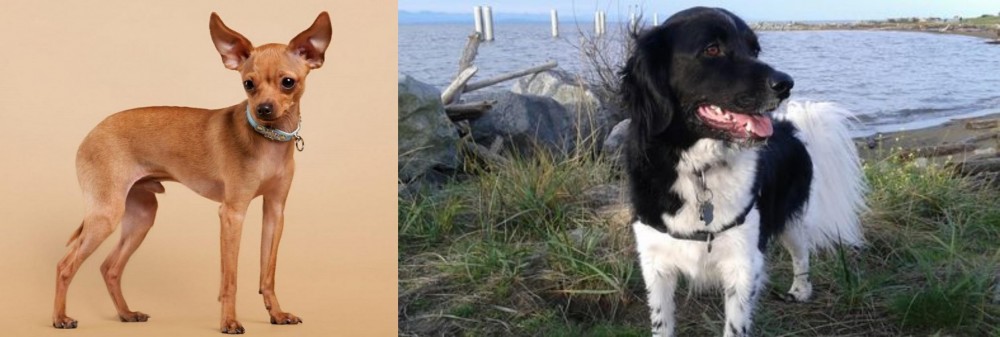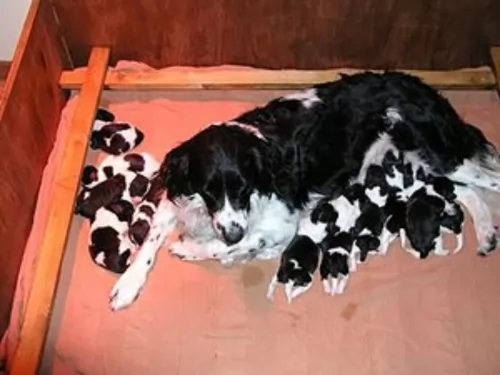 Petzlover
Petzlover Russian Toy Terrier is originated from Russia but Stabyhoun is originated from Denmark. Russian Toy Terrier may grow 25 cm / 9 inches shorter than Stabyhoun. Russian Toy Terrier may weigh 47 kg / 103 pounds lesser than Stabyhoun. Both Russian Toy Terrier and Stabyhoun has almost same life span. Both Russian Toy Terrier and Stabyhoun has almost same litter size. Both Russian Toy Terrier and Stabyhoun requires Low Maintenance.
Russian Toy Terrier is originated from Russia but Stabyhoun is originated from Denmark. Russian Toy Terrier may grow 25 cm / 9 inches shorter than Stabyhoun. Russian Toy Terrier may weigh 47 kg / 103 pounds lesser than Stabyhoun. Both Russian Toy Terrier and Stabyhoun has almost same life span. Both Russian Toy Terrier and Stabyhoun has almost same litter size. Both Russian Toy Terrier and Stabyhoun requires Low Maintenance.
 The Russian Toy Terrier is one of the dog breeds that hails from Russia in the 20th century. The Russian nobility fancied these little dogs as companions but also as they were useful for catching rats and being watchdog.They would set off an alarm with their barking.
The Russian Toy Terrier is one of the dog breeds that hails from Russia in the 20th century. The Russian nobility fancied these little dogs as companions but also as they were useful for catching rats and being watchdog.They would set off an alarm with their barking.
It is believed that the Manchester Terrier and the English Toy Terrier were the foundation breeds for this dog.
They are available in smooth and long-haired varieties. The breed has recently been recognized by the UK Kennel Club but is not yet recognized by the American Kennel Club.
 The Stabyhoun is a near extinct breed and one of the rarest ever. He was never recognized by the major kennel clubs but was entered into Foundation Stock Services.. The breed comes from the Netherlands in the Frisian Forest and has been known since the early nineteenth century.
The Stabyhoun is a near extinct breed and one of the rarest ever. He was never recognized by the major kennel clubs but was entered into Foundation Stock Services.. The breed comes from the Netherlands in the Frisian Forest and has been known since the early nineteenth century.
It was not known outside of the Friesland Forest area until the 1960’s and outside the Netherlands only since the twenty first century. The Stabyhoun is a Dutch national treasure whose name means “stand by me dog”. Today throughout the world only a few thousand remain.
The Stabyhoun is hunter and retriever with a soft-mouth and ability to point. He was used for duck hunting and finding upland birds. He is great in the water, sharp-eyes and efficient, he works quickly. The breed has also been known to hunt fox, other birds and small game. They are great at catching moles.
Even though British breeds are more popular for hunting now, the Stabij remains an excellent all round hunter. He can track, point, and retrieve. He is also a good watchdog though his disposition is peaceful and gentle. They needed to be general all around farm dogs as farmers could only afford one dog.
They have not changed much since the 1800’s either in function or appearance. In order to get such a gentle working dog, they early Stabyhoun has been mixed with the much older and rarer breed from the same area, the Wetterhoun. This crossbreeding was stopped in 1942 in order to gain breed recognition and hope to keep either of these two rare breeds from extinction.
Today the number of Stabyhoun in the Netherlands, the United Kingdom, North America and Scandinavia are slowly but surely increasing. He is highly prized as an independent thinker and hunter, inquisitive and gentle. They are related to the Heidewachtel and the Drentsche Patrijshound.
The first Staby born in the U.S. was around 1994 and in 2017 there were thought to be over 7000 Stabyhouns in the world. They are much more popular now in Europe and North America.
 The Russian Toy Terrier is a petite dog and is inclined to be a fragile dog breed. It belongs to the toy group. It is also known as the Russian Toy Terrier or the Russkiy Toy.
The Russian Toy Terrier is a petite dog and is inclined to be a fragile dog breed. It belongs to the toy group. It is also known as the Russian Toy Terrier or the Russkiy Toy.
The dog’s small size means it is ideal for living in the city or the countryside.
He measures between just 20 and 28cm and weighs between just 1kg and 3kg.
The dog has a small head with big eyes and ears which are large ad erect. The tail was always traditionally docked to give it a cute, compact look, but these days it is left long.
You also get a long-coated dog and the smooth coated dog. The long coated variety has a lot of feathering around the tail, legs and ears. Colors of the coat can be solid red, brown and tan, black and tan or greyish and tan.
This little dog is full of character and is bold and cheerful. He is such a loyal, devoted little dog and small though he is he is territorial, protecting and guarding his owner. It is such a sociable little dog, devoted to his human family, while being wary of strangers.
Even a small dog like this will need training and socialization as he can become yappy and clingy if he is constantly piked up and petted.
 The Staby are powerful soft-mouthed pointers who are not too fine or too robust with tightly fitting skin. Their chest, legs, collar and tail are feathered and make the dog look like a longhaired canine, but she really is not. The dog is longer than it is tall, and his head is longer than it is wide. Most of the breed are black and white but there are many brown and white, while the orange and white are very close to extinction.
The Staby are powerful soft-mouthed pointers who are not too fine or too robust with tightly fitting skin. Their chest, legs, collar and tail are feathered and make the dog look like a longhaired canine, but she really is not. The dog is longer than it is tall, and his head is longer than it is wide. Most of the breed are black and white but there are many brown and white, while the orange and white are very close to extinction.
They have a slightly domed skull and a slightly arched but strong neck. Their muzzle is broad and the bridge straight while the nose is well developed. With medium sized ears, set low on the head and having the bottom third of the ears covered with hair. The eyes are round, medium sized and level in the head
They have a long sleek coat with a slightly wavy croup. They are never curly. Its back is straight, tail long and loin powerful.
 The Russian Toy is a small, feisty dog with long legs and huge upright ears. He is intelligent too. Don't let his fine structure deceive you as he is far more robust and tough than he looks.
The Russian Toy is a small, feisty dog with long legs and huge upright ears. He is intelligent too. Don't let his fine structure deceive you as he is far more robust and tough than he looks.
He is a great playmate for disciplined, respectful children who know how to be kind to animals. Wild, unruly kids could so easily accidentally break one of his tiny little legs during rough play.
He loves his human family though and is guaranteed to make you an excellent little pet and companion.
 There isn’t too much information about inherited health problems with this dog and he can live to be 11, 12 or 13 years of age, maybe even longer.There are one or two health problems to be aware of -
There isn’t too much information about inherited health problems with this dog and he can live to be 11, 12 or 13 years of age, maybe even longer.There are one or two health problems to be aware of -
This condition occurs with the knee caps of the dog and either one or both back legs can be affected. Sometimes surgery will be required to help the dog.
Little dogs always battle with their teeth, and the Russian Toy Terrier can experience problems when the puppy or ‘milk’ teeth don’t fall out. It affects the development of adult teeth. Sometimes the vet even has to have the teeth removed.
 Though an isolated, rare breed for so long, the Stabyhoun does have several known health issues including:
Though an isolated, rare breed for so long, the Stabyhoun does have several known health issues including:
• PDA or Patient Ductus Arteriosis – heart issue from 6 weeks on. Major vessel does not close. With surgery it can be corrected.
• Type 1 von Willebrand’s Disease (vWB) – a bleeding disorder in its mildest form. DNA testing is available not required.
• Cerebral dysfunction – rare compulsive behavior at 6 weeks. It is fatal at this point. DNA testing will be required.
 The Russian Toy Terrier is a small breed and isn’t going to need too much exercise. However it will do him good to get out to sniff around, and a walk every day will be recommended.
The Russian Toy Terrier is a small breed and isn’t going to need too much exercise. However it will do him good to get out to sniff around, and a walk every day will be recommended.
Your Russian Toy Terrier is a fairly low maintenance dog and isn’t going to require specialist grooming. The little dog will simply require some occasional brushing to remove loose hair.
When you brush him, check inside his mouth for bad teeth as small dogs like this can suffer from pain with overcrowding of teeth.
Tiny though he is, the Russian Toy Terrier will need good food. It will be tempting to pop sugary treats into such a tiny little dog’s mouth. This can in fact be seriously dangerous for him, not to mention that he can become obese. This opens up anew set of health problems.
You can feed this little dog commercially manufactured food but it should be the best quality one for small breeds.
Give him some tasty homemade food too. Simply add into one big pot chicken, brown rice or pasta and spinach, sweet potatoes and carrots. This food can all be chopped up, refrigerated and added warmed up and in small portions to your tiny pets dry kibble once or twice a week.
A tiny bit of raw meat can also go a long way to ensuring his skin stays healthy and free of skin infections.
Ensure that there is always a bowl of fresh, cool water within his reach.
 1Feeding the puppy -They are prone to obesity. Do not overfeed. Watch calories. Feed a high quality dog food meant for active medium sized dogs in 3-4 meals per day.
1Feeding the puppy -They are prone to obesity. Do not overfeed. Watch calories. Feed a high quality dog food meant for active medium sized dogs in 3-4 meals per day.
2.Feeding the adult – Feed a high quality dog for medium sized dogs in 2-3 meals per day.
An active dog that needs exercise. They need mental stimulation as much or more than they need physical. Don’t skimp on either. They love agility, field trials, lure coursing, and scent training. They also love the triathlon, frisbee and endurance.